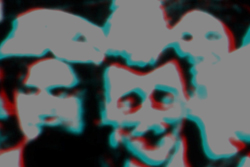Description
WARNING: This work contains throbbing light. Should not be viewed by individuals with epilepsy or seizure disorders.
Writes Jacobs: "The real subject of ANAGLYPH TOM (Tom With Puffy Cheeks) is depth-perception itself. Our beloved performers from the 1905 Tom, Tom, the Piper's Son again encapsulate human absurdity for our amusement but this time in illusionary (and berserk) 3-D. Clowns and harlots and slumming gentry freely step forward and back through the screen surface, often misplacing heads and limbs as they change location. They step from—and back into—the screen surface. This is cosmic play with all strings pulled."Here Jacobs revisits the original 1905 source material of his celebrated 1969 structuralist film, Tom Tom the Piper's Son. In his earlier film, a landmark of cinematic deconstruction, Jacobs re-photographed and manipulated a film fragment from the dawn of cinema, penetrating the image to reach the sublime. In Anaglyph Tom, the artist applies the anaglyph 3-D process to the original footage, engaging the experience of depth perception as the subject of his relentless experimentation and dizzying interventions.
Ed Halter writes in Artforum: "Less a sequel than a remake, Anaglyph Tom employs a wide array of digital techniques to once again dissect Bitzer's footage: picture-in-picture, split screens, flipping and twisting, various visual filters. But if Tom, Tom was about the investigation of narrative, Anaglyph Tom is more about an accordion-like expansion of photography's Z-axis, using 3-D to separate the crowd out into flat figures positioned in a series of overlapping planes. Jacobs provides innumerable permutations of this scenario in the course of Anaglyph Tom's roughly two hours, pushing the anaglyph system to distort and subvert normal binocular clues, creating impossible spaces and unnatural colors. While wide-ranging, the results remain a twenty-first-century coda to Jacob's initial deconstruction. But by returning to an artifact from cinema's primitive first decade, Jacobs suggests alternative histories to the technology, forking paths that point toward undiscovered possibilities."
Exhibition & Distribution Conditions
3-D glasses must be provided to viewers for any screenings or exhibitions of this title. Contact EAI for further details.
